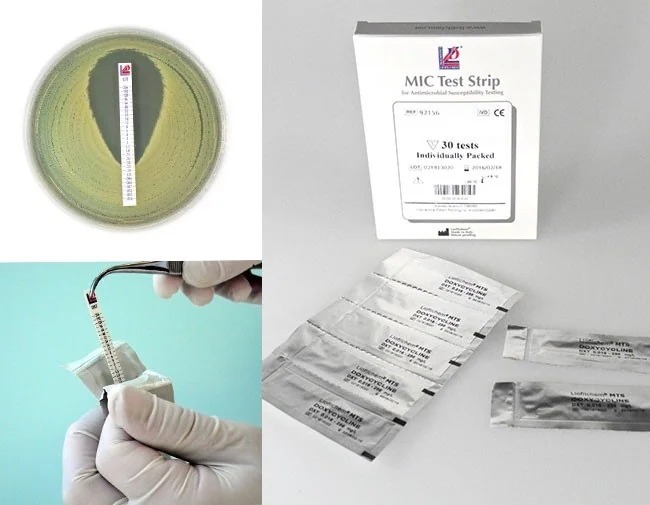Liofilchem™ MTS™ Ertapenem/Ertapenem+Phenylboronic acid ETP/EBO 0.125-8/0.032-2, MIC Test strips
Catalog No :
CAS Number :
Brand :
In Stock
Specifications:
| Application | Clinical microbiology |
| Storage Temperature | -20°C |
| Product Type | MIC Strips |
| Product Brand | Liofilchem |
| Product Grade | Microbiology grade |
Liofilchem™ MTS™ Ertapenem/Ertapenem+Phenylboronic Acid (ETP/EBO) MIC Test Strips are antimicrobial susceptibility testing products designed to detect carbapenem resistance in Enterobacteriaceae and other Gram-negative pathogens. These test strips use a combination of Ertapenem, a carbapenem antibiotic, and Phenylboronic acid, which inhibits AmpC beta-lactamases and carbapenemases, providing a detailed profile of the carbapenem resistance mechanisms present in bacterial isolates.
The test strips enable the minimum inhibitory concentration (MIC) determination, providing clinicians with critical data for guiding antibiotic treatment decisions. The combination of Ertapenem and Phenylboronic acid is used to identify beta-lactamase activity and the mechanisms of resistance that cause failure to treat with carbapenem-based antibiotics.
Features of Liofilchem™ MTS™ Ertapenem/Ertapenem+Phenylboronic Acid (ETP/EBO) 0.125-8/0.032-2 MIC Test Strips
- Combination of Ertapenem and Phenylboronic Acid: The test strips include Ertapenem, a carbapenem that is widely used to treat multi-drug resistant bacteria. Phenylboronic acid specifically targets AmpC beta-lactamases and carbapenemases, thereby detecting beta-lactamase activity in bacteria.
- MIC Range: The test strips are available with a range of 0.125–8 µg/mL for Ertapenem and 0.032–2 µg/mL for Phenylboronic acid, allowing for the precise determination of the minimum inhibitory concentration (MIC) for resistance profiling.
- Carbapenem Resistance Profiling: The MIC strips allow for the differentiation of carbapenem resistance caused by AmpC beta-lactamase production or carbapenemase production. This combination helps to detect and profile the carbapenem-resistant strains that are commonly found in hospital-acquired infections.
- Test Strips Procedure: The strips are easy to use, with straightforward application and incubation steps. The results can be interpreted within 16-20 hours of incubation, allowing for fast and reliable results.
Test Procedure
- Preparation of Inoculum:
- Prepare the bacterial inoculum from a fresh bacterial culture, equivalent to a 0.5 McFarland standard.
- Swab the inoculum evenly across an agar plate (e.g., Mueller-Hinton agar).
- Application of MIC Strips:
- Place the ETP/EBO MIC strips onto the surface of the inoculated agar plate.
- Ensure that the strips are placed 10-15 mm apart to avoid interference between the strips.
- Incubation:
- Incubate the agar plate aerobically at 37°C for 16-20 hours.
- After incubation, measure the diameter of the inhibition zone around the MIC test strips.
- Interpretation of Results:
- The zone of inhibition indicates bacterial susceptibility, and the MIC is determined based on the concentration of the antibiotic where bacterial growth is inhibited.
- Compare the zone sizes to breakpoints provided by regulatory standards such as CLSI or EUCAST to interpret the susceptibility.
Reference Data
The following reference data is based on standard breakpoints from EUCAST and CLSI guidelines. The interpretation of MIC values should be based on local guidelines, as the breakpoint values can vary.
| Organism | Ertapenem MIC Breakpoint | Interpretation | Phenylboronic acid Inhibition |
|---|---|---|---|
| Escherichia coli | ≤ 1 µg/mL | Susceptible | Inhibition of AmpC or Carbapenemases |
| Klebsiella pneumoniae | ≤ 1 µg/mL | Susceptible | Inhibition of AmpC or Carbapenemases |
| Enterobacter spp. | ≤ 1 µg/mL | Susceptible | Inhibition of AmpC or Carbapenemases |
| Pseudomonas aeruginosa | ≤ 2 µg/mL | Susceptible | - |
| Acinetobacter baumannii | ≤ 4 µg/mL | Susceptible | - |
| Enterobacter cloacae | ≤ 1 µg/mL | Susceptible | Inhibition of AmpC or Carbapenemases |
| Stenotrophomonas maltophilia | ≤ 4 µg/mL | Susceptible | - |
Control Strains
| Control Strain | Expected Result |
|---|---|
| Escherichia coli ATCC® 25922 | Susceptible to Ertapenem |
| Klebsiella pneumoniae ATCC® 700603 | Susceptible to Ertapenem |
| Enterobacter cloacae ATCC® 13047 | Susceptible to Ertapenem |
| Pseudomonas aeruginosa ATCC® 27853 | Resistant to Ertapenem |
Comparisons with Other Brands
When compared with similar products from other brands (such as Oxoid or Mast Diagnostics), Liofilchem™ MTS™ Ertapenem/Ertapenem+Phenylboronic Acid (ETP/EBO) MIC test strips offer the following benefits:
- Combination of Two Agents: Unlike some products which only include a single antimicrobial agent, the Ertapenem+Phenylboronic acid combination allows for differentiation of carbapenem-resistant bacteria based on beta-lactamase inhibition mechanisms (e.g., AmpC or carbapenemase production).
- Enhanced Selectivity: The addition of Phenylboronic acid improves the selectivity for detecting beta-lactamase-mediated resistance, making these strips particularly effective for testing strains that produce AmpC or carbapenemases.
- Ease of Use: These test strips are easy to use in routine laboratory diagnostics, providing rapid results in 16-20 hours and allowing for effective antimicrobial resistance monitoring.
- Cost-Effectiveness: Compared to other molecular testing methods (e.g., PCR), Liofilchem MIC strips provide a more affordable option while still offering accurate resistance profiling.
- Comparable Results to Molecular Testing: The strips offer results that are comparable to PCR-based testing for carbapenem resistance in terms of detection accuracy and time efficiency.
Storage Conditions
- Long-term Storage: Store the MIC test strips at -20°C for optimal performance.
- Short-term Storage: Store at 2-8°C if using for short periods.
- Shelf Life: The strips are typically stable for 24 months if stored correctly.
- Avoid: Moisture, light, and excessive heat, which may reduce the stability of the strips.
Conclusion
Liofilchem™ MTS™ Ertapenem/Ertapenem+Phenylboronic Acid (ETP/EBO) 0.125-8/0.032-2 MIC Test Strips provide a reliable, cost-effective, and rapid method for detecting carbapenem resistance in Gram-negative pathogens, particularly those expressing beta-lactamase activity. The combination of Ertapenem and Phenylboronic acid enables the detection of AmpC and carbapenemase-mediated resistance, offering invaluable information for clinicians to select appropriate antibiotic therapies.
- Pack Size: 100/pk 10/pk 30/pk




 0
0
